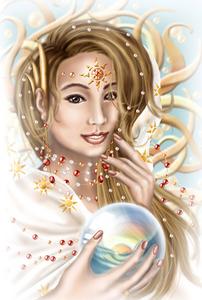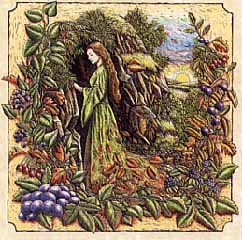
A harvest festival is held, thanking the Goddess for giving us enough sustenance to feed us through the winter. Harvest festivals of many types still occur today in farming country. This is more of the time my family celebrates 'thanksgiving' in a sense. Because this is a harvest sabbat, it is a good time to think about what you have harvested, and give thanks for the many blessings that have come to you. I use the top of my entertainment center in the family room for a permanante family alter, and I will place fall silk leaves on it, with brown and orange candles. When I lived in Ohio, fall was my favorite season, summer a close second! A traditional practice is to walk wild places and forests, gathering seed pods and dried plants. Some of these can be used to decorate the home; others saved for future herbal magick. The foods of Mabon consist of the second harvest's gleanings, so grains, fruit and vegetables predominate, especially corn. Corn bread is traditional fare, as are beans and baked squash.
During dinner time, go around the table and have everyone state what they are thankful for this year. Set a small taper candle inside a vegitable for each person to lite as they give thanks. You can use the tiny pumpkins and gourds you find in the local food shops. Polish the vegetables with a soft cloth and make sure they sit flat. With a knife, cut a hole in the center, about the diameter of the candle. Place some dripped wax in the hole to secure the candle well!
A Native American tribe from Southern California called the Chusmash celebrate their fall equinox sun ceremony during their month of Hutash (September). It takes place "after the harvest is picked, processed and stored....Kakunupmawa is a ritual name for the Sun. According to traditional Chumash lore, all humans were known as children of the Sun, or 'sons of Kakunupmawa.' The spiritual thoughts of the tribe would become focused the importance of unity in the face of winter confinement, death and rebirth.
(From Covenant of the Goddess)
Mabon falls at the Fall Equinox, or when the sun enters Libra. The Welsh name Mabon means "great son" and refers to the Son of the Great Mother. This Celtic mythological figure, who has many names and figures in many tales, was identified by the Romans as Mercury or sometimes as Apollo. In Christian Britain He was superseded by St. Michael, to whom churches on many sacred Pagan sites were dedicated, and the Fall Equinox became the Christian feast of Michaelmas. In medieval times, rents fell due and contracts were settled at Easter and at Michaelmas.
Mabon is primarily a harvest festival; it falls either during or at the end of the European grain harvest, depending on latitude. The Fall equinox is the mating season for deer, and marks the beginning of the hunting season in many places. In British folklore this time of year is associated with Herne the Hunter, who leads a wild phantom chase through the forest, heralding confusion and change. In one Craft tradition the Fall Equinox is called "the Night of the Hunter," when weak livestock which will not survive the winter must be slain. Mabon in some traditions marks the death or departure of the God in His yearly life-cycle; in others, however, this may occur at Lughnasadh or at Samhain. The Fall Equinox has also been identified as the "assumption of the Crone," when the dark face of the Goddess assumes the sway over the world which She will hold until the return of the Maiden at Imbolc.
